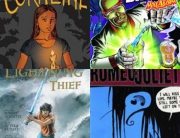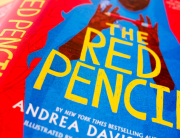When I am reading a new title, I am now looking at it with a critical Common Core eye. Of course most titles will support at least one of the initiatives set out by Common Core, but some titles stand out to me. As Booksource expands our offerings, we often consider anchor standard nine: “Analyze how two or more texts address similar themes or topics in order to build knowledge or to compare the approaches the authors take.” We want to make sure our titles allow for strong literature connections to the types of literature that are mentioned in the grade specific standards. Below is a list of some fantastic new Common Core standouts!
Titles that Connect to Classic Literature:
Navigating Early by Clare Vanderpool (Grades 4-7, Lexile 790)
The year is 1945 and following the death of his mother, Jack Baker’s naval officer father has moved him to an all-boys boarding school in Maine. Born and raised in Kansas, Jack is  a fish out of water in this new seafaring setting. As he struggles to fit in with his classmates, he meets Early Auden, a boy who seems to be an even bigger outcast than him. Early is a mystery. He shows up only sporadically to class (with no seeming consequences); he lives in the janitor’s closet; he only listens to Billie Holiday (but only when it rains). All things considered, Early seems to be a remarkable boy, not to mention a genius. When Jack and Early find themselves alone at school over holiday break, the friends embark on a journey to the nearby Appalachian mountains. There they search for a great black bear that has been in the news—and is a mysterious obsession for Early. On this journey, Jack uncovers some of the mystery behind Early Auden. He faces his own past, as well. This amazing story of friendship and self-discovery has made it onto my Newbery picks list!
a fish out of water in this new seafaring setting. As he struggles to fit in with his classmates, he meets Early Auden, a boy who seems to be an even bigger outcast than him. Early is a mystery. He shows up only sporadically to class (with no seeming consequences); he lives in the janitor’s closet; he only listens to Billie Holiday (but only when it rains). All things considered, Early seems to be a remarkable boy, not to mention a genius. When Jack and Early find themselves alone at school over holiday break, the friends embark on a journey to the nearby Appalachian mountains. There they search for a great black bear that has been in the news—and is a mysterious obsession for Early. On this journey, Jack uncovers some of the mystery behind Early Auden. He faces his own past, as well. This amazing story of friendship and self-discovery has made it onto my Newbery picks list!
Classroom Connection: Navigating Early’s strong parallels to Homer’s Odyssey are hard to miss. Use this title with the graphic adaptation by Gareth Hinds to introduce this archetypal story. The powerful adaptation is appropriate for younger readers and offers opportunities for students to make strong text-to-text connections.
Zebra Forest by Adina Rishe Gewirtz (Grades 4-7)
Annie lives with her brother, Rew, and grandmother, Gran, in a broken-down house on the edge of the Zebra Forest, so named because from a distance  the birch and oak trunks resemble black and white stripes. The children have a somewhat unstable life—Gran is a hoarder and suffers spells of debilitating depression. Rew and Annie miss a lot of school and have frequent visits from a social worker. Despite all of this, they are bright and responsible. Gran is a witty, colorful, old gal, and when she isn’t having one of her spells, she is a great caretaker. Although their home is full of clutter and filth, a lot of the clutter is a combination of books and Life magazines, so Annie and Rew are exposed to a lot of reading material. They spend countless hours with each other in the Zebra Forest. During these retreats into the forest they tell their own imagined stories, many of which involve their dad who presumably died when they were young. One stormy night, there is a knock at the door. It is an escapee from a nearby prison who holds the family hostage and changes all of their lives forever.
the birch and oak trunks resemble black and white stripes. The children have a somewhat unstable life—Gran is a hoarder and suffers spells of debilitating depression. Rew and Annie miss a lot of school and have frequent visits from a social worker. Despite all of this, they are bright and responsible. Gran is a witty, colorful, old gal, and when she isn’t having one of her spells, she is a great caretaker. Although their home is full of clutter and filth, a lot of the clutter is a combination of books and Life magazines, so Annie and Rew are exposed to a lot of reading material. They spend countless hours with each other in the Zebra Forest. During these retreats into the forest they tell their own imagined stories, many of which involve their dad who presumably died when they were young. One stormy night, there is a knock at the door. It is an escapee from a nearby prison who holds the family hostage and changes all of their lives forever.
Classroom Connection: Annie and Rew’s favorite book is Treasure Island, hands down. Stand on your desk or a chair and do a dramatic reading of some of their favorite lines. This will give you the opportunity to do a book talk on a classic story. Discuss the colorful language of these excerpts from Treasure Island and the context from which the lines have been taken. Some students will want to experience this classic in its entirety. Yo-ho-ho, and a bottle of rum!
Titles that Connect to Mythology and Traditional Literature:
Mouse, Bird, Snake, Wolf by David Almond (Grades 2-5)
When the gods who created the world become lazy, three young people take it upon themselves to create things to fill the empty spaces in their incomplete world. They conjure up  a mousy thing, a chirpy thing, and a twisty thing. As their creations get more complicated and powerful, the danger of their new creations becomes apparent. This stunningly illustrated tale depicts a fictional creation myth where people have the power to create the wonders (and hazards) of their world.
a mousy thing, a chirpy thing, and a twisty thing. As their creations get more complicated and powerful, the danger of their new creations becomes apparent. This stunningly illustrated tale depicts a fictional creation myth where people have the power to create the wonders (and hazards) of their world.
Classroom Connection: Introduce your students to Greek mythology using books like D’Aulaires’ Book Of Greek Myths (Grades 4-8). This title includes the Greek creation myth and overviews of most of the Greek gods and goddesses highlighting their contributions to the world. Let the questions begin. Do humans play an important role in these myths? Do humans help to create the world around them in real life? What can we take away from this modern myth?
The Sleepwalkers by Viviane Schwarz (Grades 2-5)
The Sleepwalkers are the guardians of dreams, and the current crew, made up of three sheep, is up for retirement. They create their replacements (a bear, monkey, and crow) and train them in the art of fighting nightmares. The Sleepwalkers essentially go into children’s nightmares to help fight off whatever scares them. My  favorite nightmare was about a boy who dreamt he was falling to his inevitable death (I’ve had that dream before!). The Sleepwalkers pointed out that he was falling through a bottomless dream so he would never hit the ground. This turned the nightmare into an out-of-this-world fantasy where the boy could flip and fall without fear! As the new recruits train, they must first overcome some of their own fears so that others can sleep soundly.
favorite nightmare was about a boy who dreamt he was falling to his inevitable death (I’ve had that dream before!). The Sleepwalkers pointed out that he was falling through a bottomless dream so he would never hit the ground. This turned the nightmare into an out-of-this-world fantasy where the boy could flip and fall without fear! As the new recruits train, they must first overcome some of their own fears so that others can sleep soundly.
Classroom Connection: Discuss how and why myths are created. Pretend that The Sleepwalkers is a real myth. Why would a myth like this develop? Next, have your students create their own graphic novel panels of a scary dream scenario where they imagine how a Sleepwalker could turn it around. Be sure to conference with them on their story idea before they begin. Check out ReadWriteThink’s free Comic Creator!
Titles that Connect to Primary Source Documents:
The Boy On The Wooden Box by Leon Leyson (Grades 4-7)
Many are familiar with Oskar Schindler because of Steven Spielberg’s movie, Schindler’s List. Schindler was a German businessman and Nazi party member who ran ammunition and enamelware factories. He saved the lives of hundreds of Jewish people by employing them in his factories. The Boy  On The Wooden Box is a memoir by one of the youngest children saved by Oskar Schindler. The title stems from the fact that Leon was so small and skinny that he had to stand on a wooden box to reach the ceramic factory machines at which he was assigned to work. Leyson captures the essence of himself as an innocent, young child perfectly. Remarkably, he leaves it there and seeks to make no other impression. There is no bitterness in his story.
On The Wooden Box is a memoir by one of the youngest children saved by Oskar Schindler. The title stems from the fact that Leon was so small and skinny that he had to stand on a wooden box to reach the ceramic factory machines at which he was assigned to work. Leyson captures the essence of himself as an innocent, young child perfectly. Remarkably, he leaves it there and seeks to make no other impression. There is no bitterness in his story.
Classroom Connection: Use this title as an opportunity to discuss primary source documents. Explore pictures, letters, and drawings from the holocaust. Have your students infer from these sources. What can these documents tell us? Discuss the importance of primary source documents in the retelling of history.





Leave A Comment